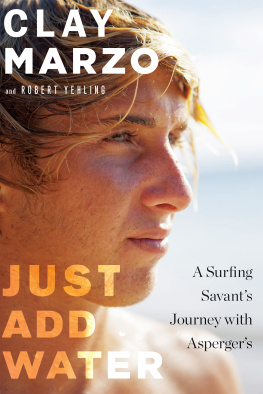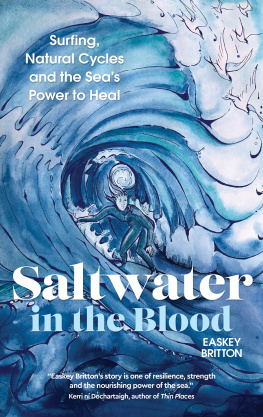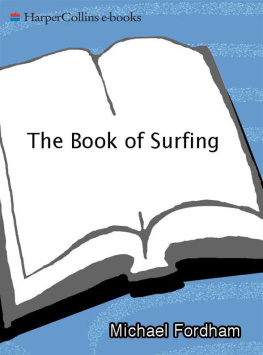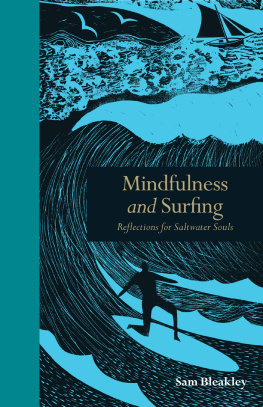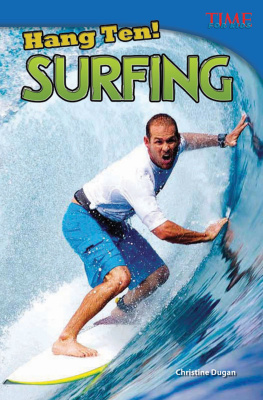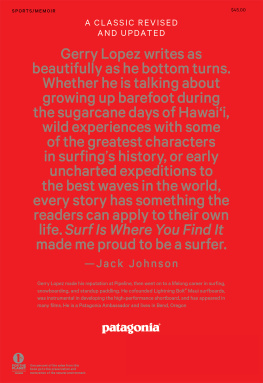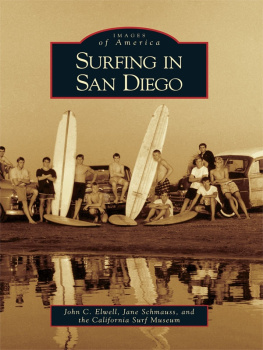Copyright 2015 by Clay Marzo and Robert Yehling
All rights reserved
For information about permission to reproduce selections from this book, write to Permissions, Houghton Mifflin Harcourt Publishing Company, 215 Park Avenue South, New York, New York 10003.
www.hmhco.com
The Library of Congress has cataloged the print edition as follows:
Marzo, Clay.
Just add water : a surfing savants journey with Aspergers / Clay Marzo, Robert Yehling.
pages cm
ISBN 978-0-544-25621-7 (hardback) ISBN 978-0-544-25317-9 (ebook)
1. Marzo, Clay. 2. SurfersUnited StatesBiography. 3. Aspergers syndromePatientsBiography. I. Yehling, Robert. II. Title.
GV 838. M 375 A 3 2015
797.3'2092dc23
[B]
2014034432
Jacket design by Patrick Barry
Jacket photograph Marco Garcia
v1.0715
To my family, and to everyone who struggles when told they cannot do something. Get out there and do itand make your world and ours greater.
In the Pocket
Theres a set! Look at the set coming! Look at the first one barreling... here comes onelook at this one, dude! See how you go underground when youre in there, then it throws you into the shallow? Sometimes theres a little left that goes into the bay, a re-form that happens when it gets really bigbut youd rather surf somewhere else... you dont want to surf out here when its bigger than five or six feet. It gets too gnarly, closes out, and throws you on that shallow reef. This is a small wave spot. Its the steepest small wave around. Its best when its glassy, but the winds coming from a weird direction... see how the wave is balling up?
That was a big set we saw earlier, so much bigger than anything else... that was the north influence. The south influence pushes into the total wave shape. It breaks from two directions here, sometimes at the same time. It gives me a thrill, this kind of wave.
The pristine waters off Mauis west coast convey majesty and presence befitting the ancient Polynesian Sport of Kings. They are about to be stirred by a tall, angular magician with a swimmers build and moves that very few on earth can match. Every time Clay Marzo enters the Pacificnearly every sunlit hour of every day hes not traveling, if the waves cooperatehe paddles out to commingle with his soul, which seems to breathe with gills. Waves come to him as if silently summoned, enabling him to turn around, drop in, and unleash rides so dynamic, outrageous, daring, and graceful that youre left grasping for superlatives. He speeds through waves like a dolphin, explodes off the top like an attacking leopard, inverts and bends into impossible positions like an Olympic gymnast... and always seems to land on his feet. Like a cat.
Such is the case on a warm morning charged with sea spray and crowded surf spots, which can mean only one thing: the waves are pounding. The seasons first major northwest swell has arrived, bringing waves up to forty feet at infamous Peahi, or Jaws, where tow-in surfers risk their lives as they tackle the monsters calved by a disturbance in the Aleutian Islands, far to the north. Meanwhile, at a break called Windmills, Clay Marzo sits with a videographer, fifteen miles and a world away from the nineteenth-century colonial seaside mystique of Lahaina and the luxury resorts on Kaanapali Beach. To the southeast, Haleakala towers two miles above the island, a conic crown and dormant volcano where Jimi Hendrix once played live, where silence surpassed only by space exists.
Silence. Nothing suits Clay better. He is entirely silent as he faces west, his hands smacking the steering wheel, his body twitching. He surveys the horizon, then the lineup, where waves peel in both directions from their breaking point. His mind works out the wave angles, where they break, how they break, and how the current and ever-present trade winds impact them. When wave faces approach fifteen feet, as they do at Windmills on this day, good choices can become life-saving choices. His focus is laserlike, absolute. Nothing can or will interrupt his concentration.
After studying the waves for forty-five minutes, Clay grabs his board and moves toward the ocean. He walks away from his life on land, a mighty and never-ending struggle between the way his brain is wired and the noise, crowds, social interactions, expectations, anxieties, and facial expressions the rest of us use to get by. He negotiates the everyday world clumsily, always a step off or to the side, it seems. If hes connected to it at all, which is often not the case. If the activity of the moment isnt about surfing, eating, basketball, music, or his girlfriend, Jade Barton, hes oblivious. Uncomfortable.
Theres nothing uncomfortable about the way he approaches the ocean. His coordination while walking rocks and steep trails is superior, rhythmic, and smoother than the way most people amble down the road. His eyes scan from side to side, watching the action of every wave, calculating where to paddle out and position himself. He throws himself into the frothing shorebreak, surfaces, shakes his head a few times, yells out with excitement (or is it the relief of no longer being on land?), and sets off in the direction of the neighboring island of Lanai with paddle strokes that his videographer, Adam Klevin, calls the best Ive ever seen. He would win every paddle battle there is. Hands down.
Minutes later, a set of twelve- to fifteen-foot behemoths approaches. Clay paddles into position. He notices a bump in the wave, a subtle shift beyond the sensory range of most humans. He wheels his board around and strokes to a point hes already predetermined and anticipated through knowledge and intuition. His deep, powerful strokes are those of a champion swimmer. His instincts are beyond that. When a wave emerges and jacks up to its full two-story height, Clay sits in perfect position. With a GoPro camera mounted on the back of his board, he paddles hard, easily catches the wave, and looks down the line, his right foot forward, the direction in which he faces the wave.
Let the show begin. Clay connects in a way one would imagine Mozart diving into the wellspring of his latest symphony, Beethoven hugging the floor with his deaf ear to feel the vibration of his Fifth Symphony, or Monet immersing himself in French light. He races down the wave face as it peels behind him, seemingly at one with it. Clay leans like a motorcycle street racer into a deep bottom turn and propels himself up the face, then slots himself inside the pocket of the wave.
Just like that, hes gone. Disappeared. Out of view. Spectators on the rocky beach or in their cars wonder the same thing: is he coming out?
Seconds later he emerges, arms raised high, GoPro still in his mouth, the shot of him scorching a nasty Windmills barrel certain to be played over and over on his flat-screen later in the day. And soon, on video throughout the world. Whenever Clay Marzo hits it big, the beach buzzes and the world finds out soon enough. Kids off the charts, says Les Potts, a longboard surfing legend whos produced and witnessed plenty of greatness in his fifty years of surfing. Howd he find that tube?
This is where rides usually end, where most surfers pull out and paddle into position for another wave while story-building their ride to everyone else in the lineup.
Clay is warming up for round two. His fans on the beach wonder, what the hell is he going to do next? They cannot guess, but they know they may see something no other surfer in the world will attempt, let alone execute successfully. Anything is possible.
Clay whips to the bottom of the wave to gain speed and propulsion, then smacks it off the top, getting a few feet of air before landing in the wave. He throws the tail of his board sideways, like a skateboarder in a half-pipe, leaving a rooster tail of displaced water, and descends onto the diminishing lip
Next page
